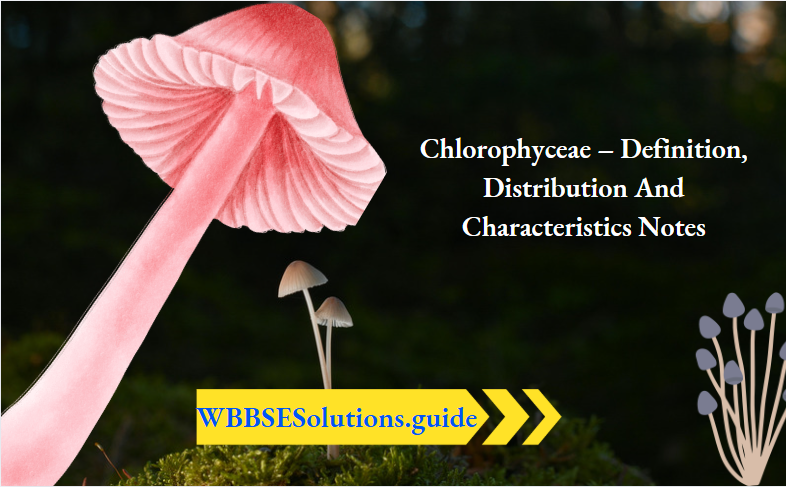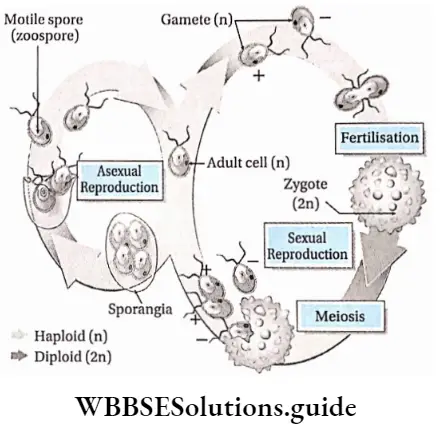Chlorophyceae (Green algae)
Chlorophyceae Definition: The Chlorophyceae (Greek: chloros=green;phyton=plant) are unicellular or multicellular, green-coloured freshwater algae.
Chlorophyceae
They contain pigments like chlorophyll a, b and carotenes. They include some of the most common species, as well as many members that are important both ecologically and scientifically.
Chlorophyceae Distribution: About 90% of Chlorophycean algae are generally found in fresh water and the rest are marine, terrestrial, etc. The freshwater members such as Volvox sp., Oedogonium sp., Spirogyra sp., etc., grow in ponds, pools and lakes. They are also found attached to the roots, branches of trees, hot springs, soil and even in snow.
Read and Learn More: WBCHSE Notes for Class 11 Biology
Some of the members of Chlorophyceae remain in symbiotic association with fungus, to form lichens. Some are epiphytic in nature, growing on trees (for example Trentepohlia sp.) or on animals (Cladophora sp.). Some are parasitic (for example Cephaleuros sp.), that grow on other plants.
Features Of Green Algae
Chlorophyceae General Features:
1. They show a wide range of variations in their thallus structures. They may be unicellular motile (for example Chlamydomonas sp.) to non-motile (for example Chlorella sp.), coenobium (for example Volvox sp.), palmelloid (for example, Tetraspora sp.) to dendroid (for example Ecballocystis sp.), colony forming (for example Volvox sp.) to free-living (for example Chlamydomonas sp.), filamentous branched (for example Cladophora sp.) and unbranched (for example Spirogyra sp.), heterotrichous (for example Coleochaete sp.), saponaceous (for example, Vaucheria sp.) and parenchymatous (for example Ulva sp.).
| Class 11 Biology | Class 11 Chemistry |
| Class 11 Chemistry | Class 11 Physics |
| Class 11 Biology MCQs | Class 11 Physics MCQs |
| Class 11 Biology | Class 11 Physics Notes |
Chlorophyceae definition, distribution, and characteristics notes PDF
2. Flagella may be one to many, equal in size and inserted either apically or sub-apically. The flagella show a typical 9+2 arrangement when viewed under an electron microscope. Some algae like Chlorella sp. have no flagella at all. Some algae have 2-4 whiplash flagella at the anterior part, as in Chlamydomonas sp.
3. Usually, there is only a single nucleus (for example Chlamydomonas sp.) in each cell. In some algae like Vaucheria sp., Cladophora sp., etc., the thallus is multinucleated and coenocytic. Normally the number of nucleolus is one per nucleus, but some algae have several nucleoli.
4. The cell wall is mainly made up of cellulose, comprised of hydroxyproline glycosides or polysaccharides, like, xylans and mannans. In Chara sp., the cell wall is encrusted with calcium and magnesium carbonate. In Chlamydomonas sp., the cell wall is made of glycoproteins.

5. Semi-permeable cell membrane encircles the protoplast that contains many small vacuoles. The vacuoles push the protoplast towards the periphery to form a thin layer, called the primordial utricle.
6. The members of Chlorophyceae have chloroplasts with different shapes. For example, the chloroplast is cup-shaped (Chlamydomonas sp.), spiral (Spirogyra sp.), reticulate (Oedogonium sp.), star-shaped (Zygnema sp.), girdle-shaped (Ulothrix sp.). The pigments are located within the chloroplast.
Green Algae Diagram

7. Chloroplast generally contains pyrenoids (starch molecules coated with proteins). The main pigments are chlorophylls a and b, or and /3-carotenes and xanthophylls. Due to the presence of photosynthetic pigments, they are generally autotrophic.
8. The flagellated cells have a photosensory organ called an eye spot or stigma embedded in the chloroplast.
9. The reserve food of all chlorophycean members is starch.
Chlorophyceae definition, distribution, and characteristics notes PDF
10. They reproduce vegetatively (cell division, fragmentation, etc.), asexually (zoospores, aplanospore, akinete, etc.) and sexually (isogamy, anisogamy or oogamy).
11. The plant body is haploid and the zygote or oospore is the only diploid structure in their life cycle.
12. The life cycle is mainly haplontic (Volvox sp., Ulothix sp. and Chlamydomonas sp.). Some had diplontic (Caulerpa sp.) and haplo-diplobiontic (Ulva sp.) life cycles.
